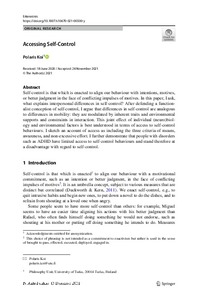Accessing Self-Control
Koi Polaris
Accessing Self-Control
Koi Polaris
SPRINGER
Julkaisun pysyvä osoite on:
https://urn.fi/URN:NBN:fi-fe2022012710676
https://urn.fi/URN:NBN:fi-fe2022012710676
Tiivistelmä
Self-control is that which is enacted to align our behaviour with intentions, motives, or better judgment in the face of conflicting impulses of motives. In this paper, I ask, what explains interpersonal differences in self-control? After defending a functionalist conception of self-control, I argue that differences in self-control are analogous to differences in mobility: they are modulated by inherent traits and environmental supports and constraints in interaction. This joint effect of individual (neuro)biology and environmental factors is best understood in terms of access to self-control behaviours. I sketch an account of access as including the three criteria of means, awareness, and non-excessive effort. I further demonstrate that people with disorders such as ADHD have limited access to self-control behaviours and stand therefore at a disadvantage with regard to self-control.
Kokoelmat
- Rinnakkaistallenteet [27094]
